The Intel Optane SSD DC P4800X (375GB) Review: Testing 3D XPoint Performance
by Billy Tallis on April 20, 2017 12:00 PM ESTSequential Read
Intel provides no specifications for sequential access performance of the Optane SSD DC P4800X. Buying an Optane SSD for a mostly sequential workload would make very little sense given that sufficiently large flash-based SSDs or RAID arrays can offer plenty of sequential throughput. Nonetheless, it will be interesting to see how much faster the Optane SSD is with sequential transfers instead of random access.
Sequential access is usually tested with 128kB transfers, but this is more of an industry convention and is not based on any workload trend as strong as the tendency for random I/Os to be 4kB. The point of picking a size like 128kB is to have transfers be large enough that they can be striped across multiple controller channels and still involve writing a full page or more to the flash on each channel. Real-world sequential transfer sizes vary widely depending on factors like which application is moving the data or how fragmented the filesystem is.
Even without a large native page size to its 3D XPoint memory, we expect the Optane SSD DC P4800X to exhibit good performance from larger transfers. A large transfer requires the controller to process fewer operations for the same amount of user data, and fewer operations means less protocol overhead on the wire. Based on the random access tests, it appears that the Optane SSD is internally managing the 3D XPoint memory in a way that greatly benefits from transfers being at least 4kB even though the drive emulates a 512B sector size out of the box.
The drives were preconditioned with two full writes using 4kB random writes, so the data on each drive is entirely fragmented. This may limit how much prefetching of user data the drives can perform on the sequential read tests, but they can likely benefit from better locality of access to their internal mapping tables.
Queue Depth 1
The test of sequential read performance at different transfer sizes was conducted at queue depth 1. Each transfer size was used for four minutes, and the throughput was averaged over the final three minutes of each test segment.
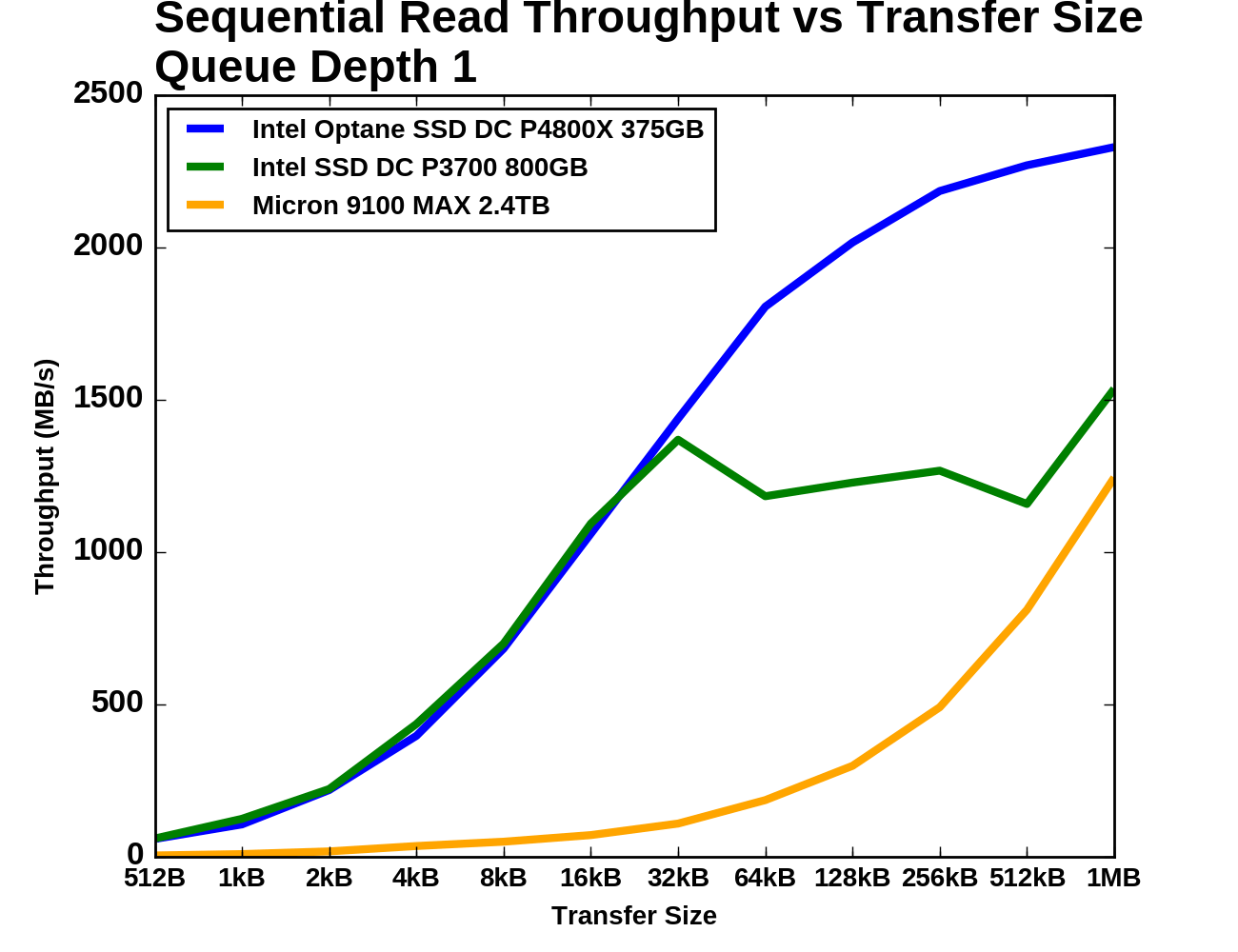 |
|||||||||
| Vertical Axis scale: | Linear | Logarithmic | |||||||
For transfer sizes up to 32kB, both Intel drives deliver similar sequential read speeds. Beyond 32kB the P3700 appears to be saturated but also highly inconsistent. The Micron 9100 is plodding along with very low but steadily growing speeds, and by the end of the test it has almost caught up with the Intel P3700. It was at least ten times slower than the Optane SSD until the transfer size reached 64kB. The Optane SSD passes 2GB/s with 128kB transfers and finishes the test at 2.3GB/s.
Queue Depth > 1
For testing sequential read speeds at different queue depths, we use the same overall test structure as for random reads: total queue depths of up to 64 are tested using a maximum of four threads. Each thread is reading sequentially but from a different region of the drive, so the read commands the drive receives are not entirely sorted by logical block address.
The Optane SSD DC P4800X starts out with a far higher QD1 sequential read speed than either flash SSD can deliver. The Optane SSD's median latency at QD1 is not significantly better than what the Intel P3700 delivers, but the P3700's 99th and 99.999th percentile latencies are at least an order of magnitude worse. Beyond QD1, the Optane SSD saturates while the Intel P3700 takes a temporary hit to throughput and a permanent hit to latency. The Micron 9100 starts out with low throughput and fairly high latency, but with increasing queue depth it manages to eventually surpass the Optane SSD's maximum throughput, albeit with ten times the latency.
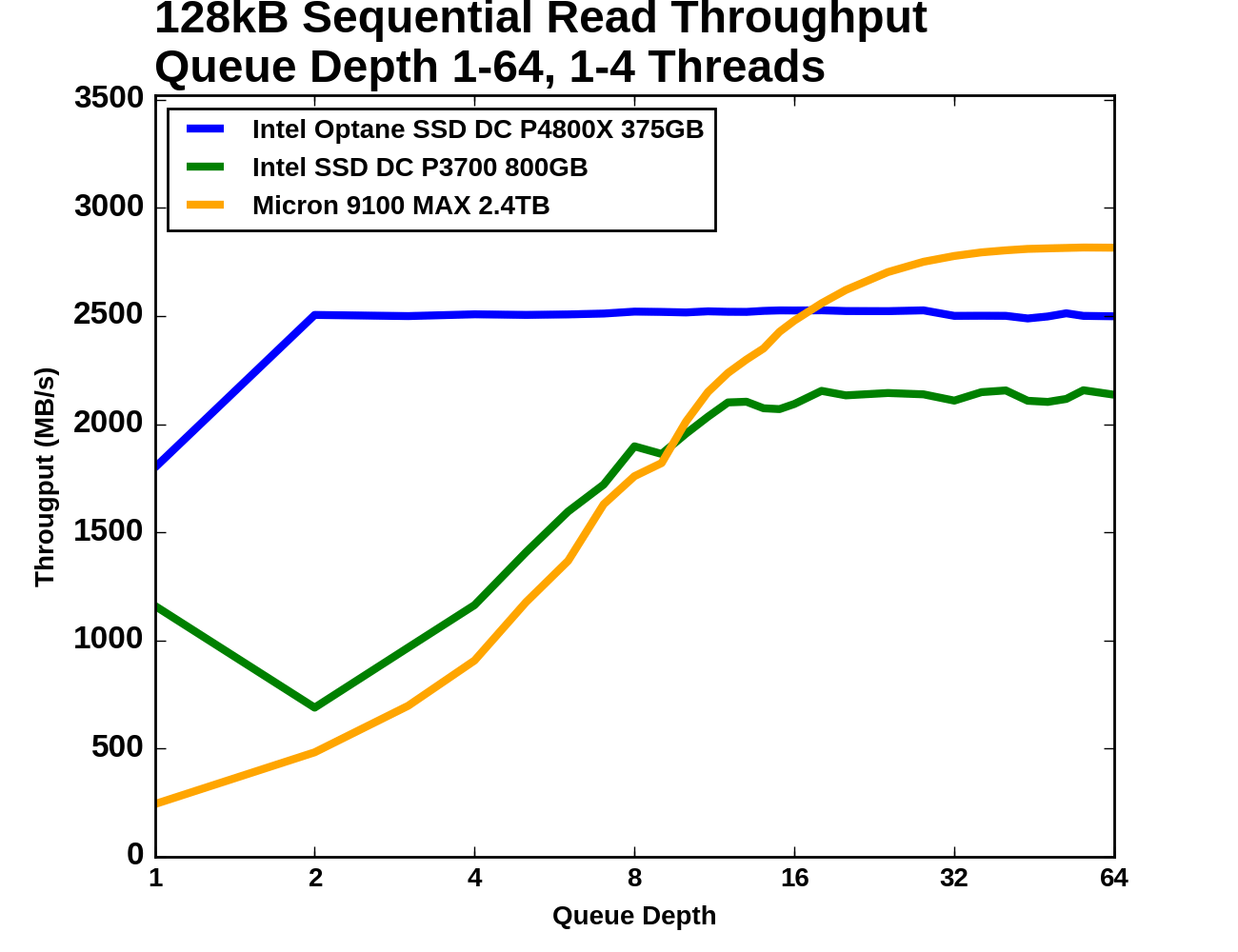 |
|||||||||
| Vertical Axis units: | IOPS | MB/s | |||||||
The Intel Optane SSD DC P4800X starts this test at 1.8GB/s for QD1, and delivers 2.5GB/s at all higher queue depths. The Intel P3700 performs significantly worse when a second QD1 thread is introduced, but by the time there are four threads reading from the drive the total throughput has recovered. The Intel P3700 saturates a little past QD8, which is where the Micron 9100 passes it. The Micron 9100 then goes on to surpass the Optane SSD's throughput above QD16, but it too has saturated by QD64.
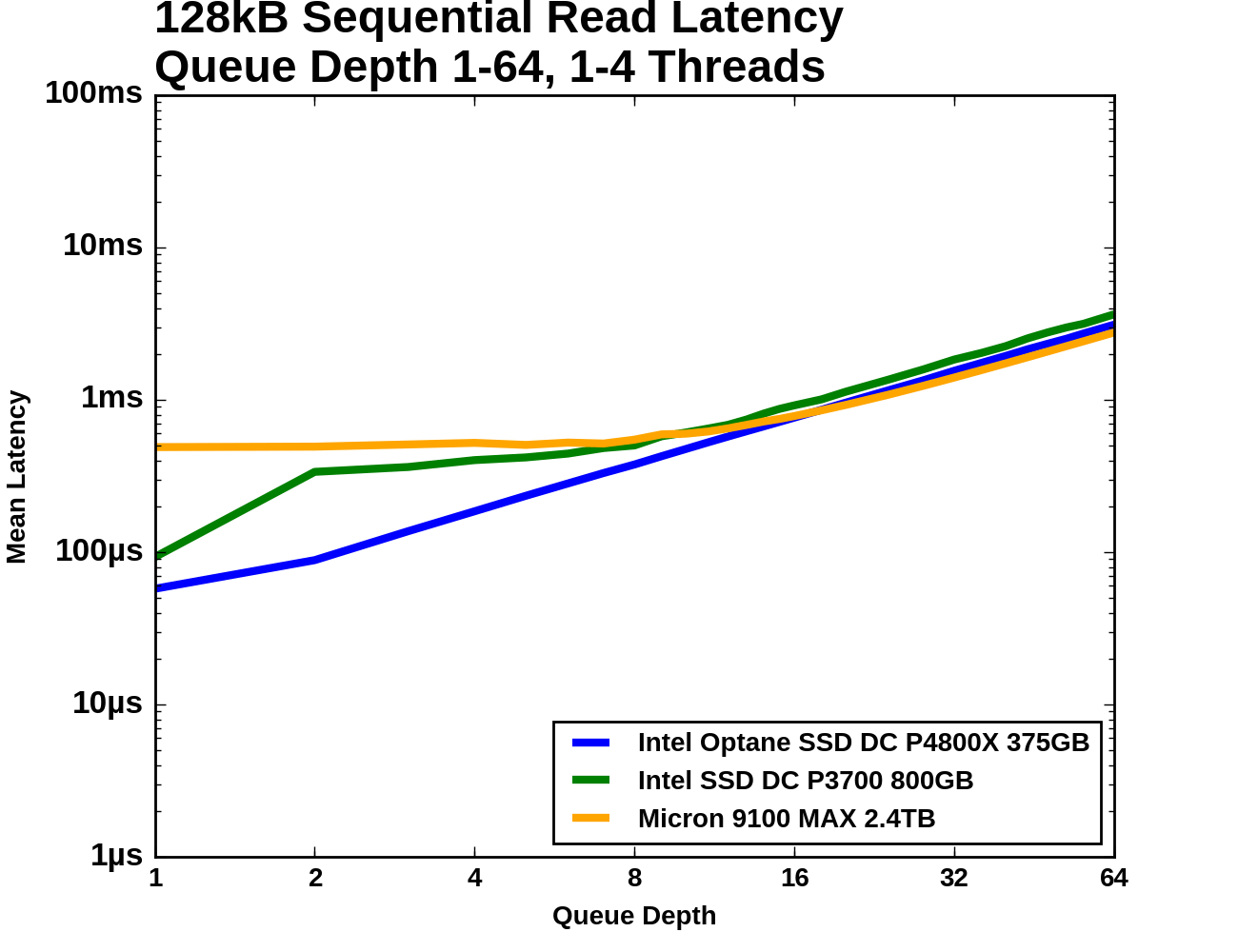 |
|||||||||
| Mean | Median | 99th Percentile | 99.999th Percentile | ||||||
The Optane SSD's latency increases modestly from QD1 to QD2, and then unavoidably increases linearly with queue depth due to the drive being saturated and unable to offer any better throughput. The Micron 9100 starts out with almost ten times the average latency, but is able to hold that mostly constant as it picks up most of its throughput. Once the 9100 passes the Optane SSD in throughput it is delivering slightly better average latency, but substantially higher 99th and 99.999th percentile latencies. The Intel P3700's 99.999th percentile latency is the worst of the three across almost all queue depths, and its 99th percentile latency is only better than the Micron 9100's during the early portions of the test.
Sequential Write
The sequential write tests are structured identically to the sequential read tests save for the direction the data is flowing. The sequential write performance of different transfer sizes is conducted with a single thread operating at queue depth 1. For testing a range of queue depths, a 128kB transfer size is used and up to four worker threads are used, each writing sequentially but to different portions of the drive. Each sub-test (transfer size or queue depth) is run for four minutes and the performance statistics ignore the first minute.
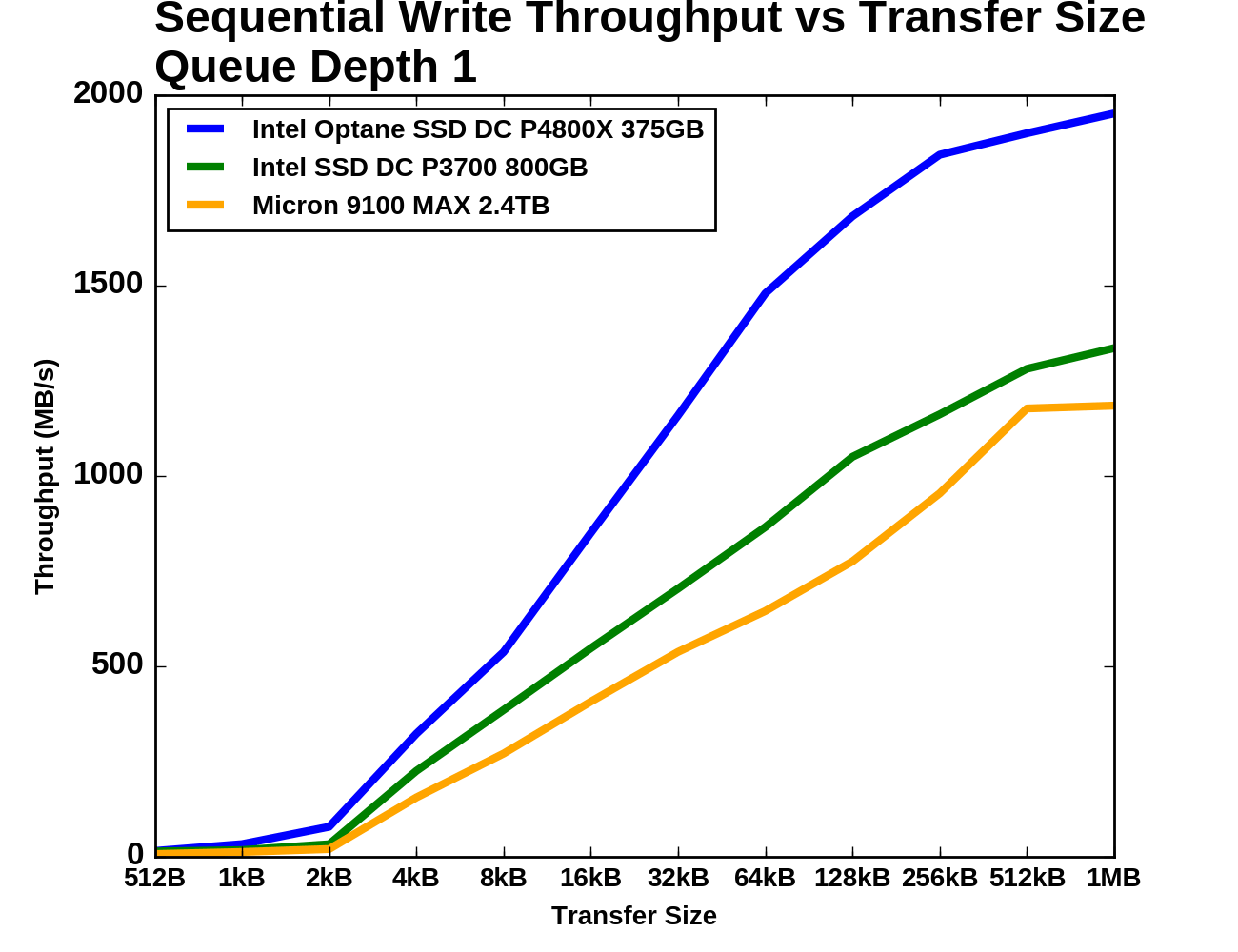 |
|||||||||
| Vertical Axis scale: | Linear | Logarithmic | |||||||
As with random writes, sequential write performance doesn't begin to take off until transfer sizes reach 4kB. Below that size, all three SSDs offer dramatically lower throughput, with the Optane SSD narrowly ahead of the Intel P3700. The Optane SSD shows the steepest growth as transfer size increases, but it and the Intel P3700 begin to show diminishing returns beyond 64kB. The Optane SSD almost reaches 2GB/s by the end of the test while the Intel P3700 and the Micron 9100 reach around 1.2-1.3GB/s.
Queue Depth > 1
When testing sequential writes at varying queue depths, the Intel SSD DC P3700's performance was highly erratic. We did not have sufficient time to determine what was going wrong, so its results have been excluded from the graphs and analysis below.
The Optane SSD DC P4800X delivers better sequential write throughput at every queue depth than the Micron 9100 can deliver at any queue depth. The Optane SSD's latency increases only slightly as it reaches saturation while the Micron 9100's 99th percentile latency begins to climb steeply well before that drive reaches its maximum throughput. The Micron 9100's 99.999th percentile latency also grows substantially as throughput increases, but its growth is more evenly spread across the range of queue depths.
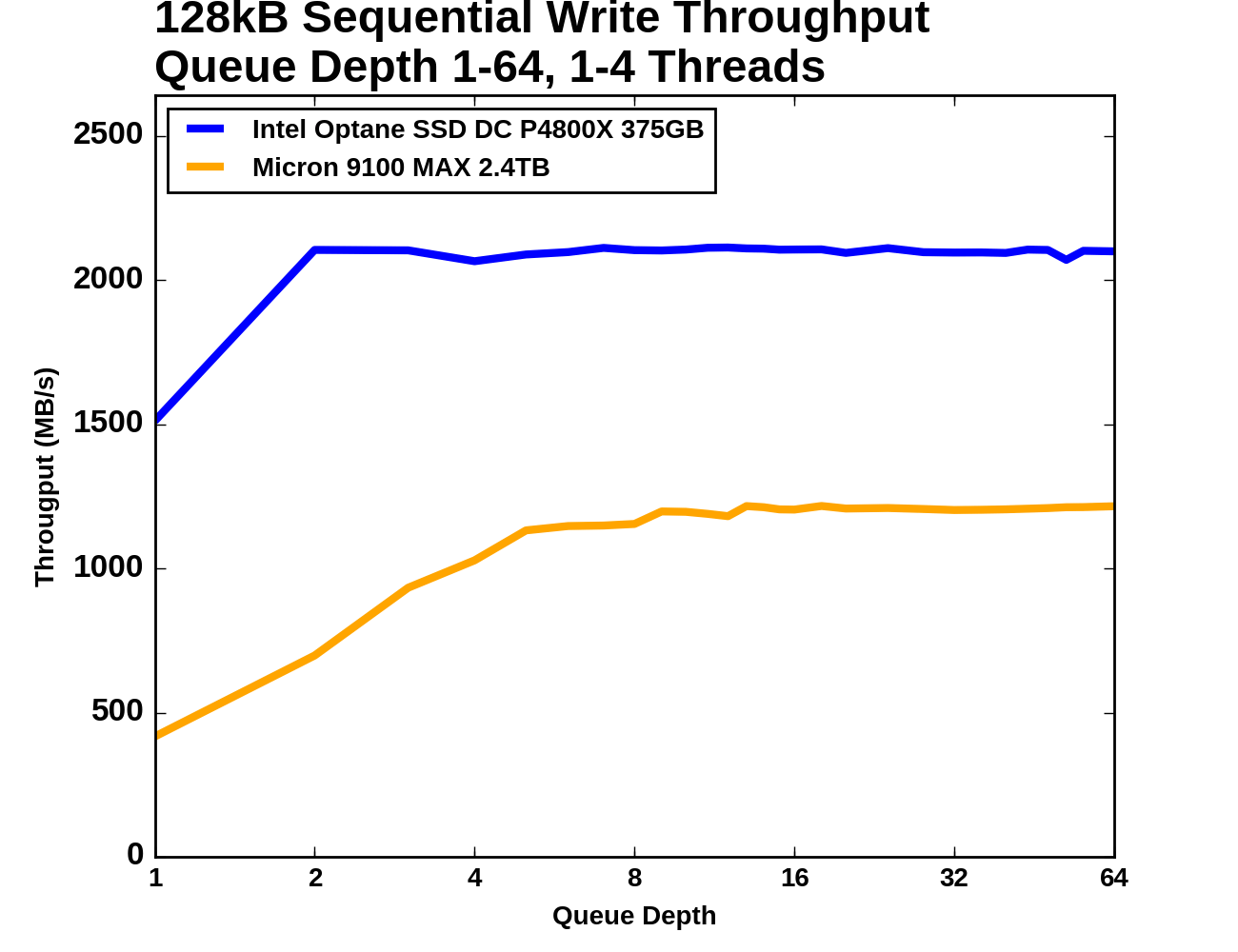 |
|||||||||
| Vertical Axis units: | IOPS | MB/s | |||||||
The Optane SSD reaches its maximum throughput at QD2 and maintains it as more threads and higher queue depths are introduced. The Micron 9100 only provides a little over half of the throughput and requires a queue depth of around 6-8 to reach that performance.
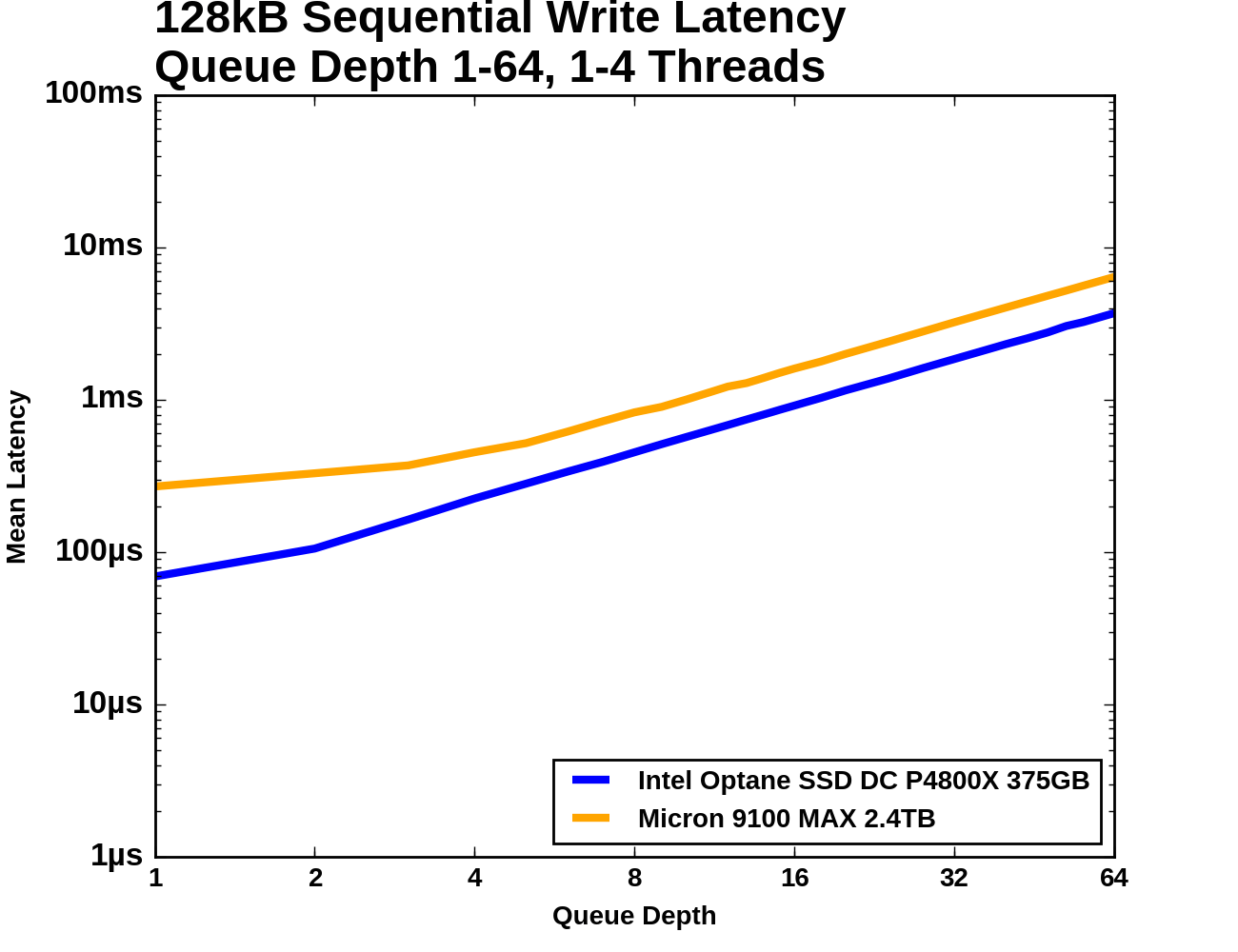 |
|||||||||
| Mean | Median | 99th Percentile | 99.999th Percentile | ||||||
The Micron 9100's 99th percentile latency starts out around twice that of the Optane SSD, but at QD3 it increases sharply as the drive approaches its maximum throughput until it is an order of magnitude higher than the Optane SSD. The 99.999th percentile latencies of the two drives are separated by a wide margin throughout the test.


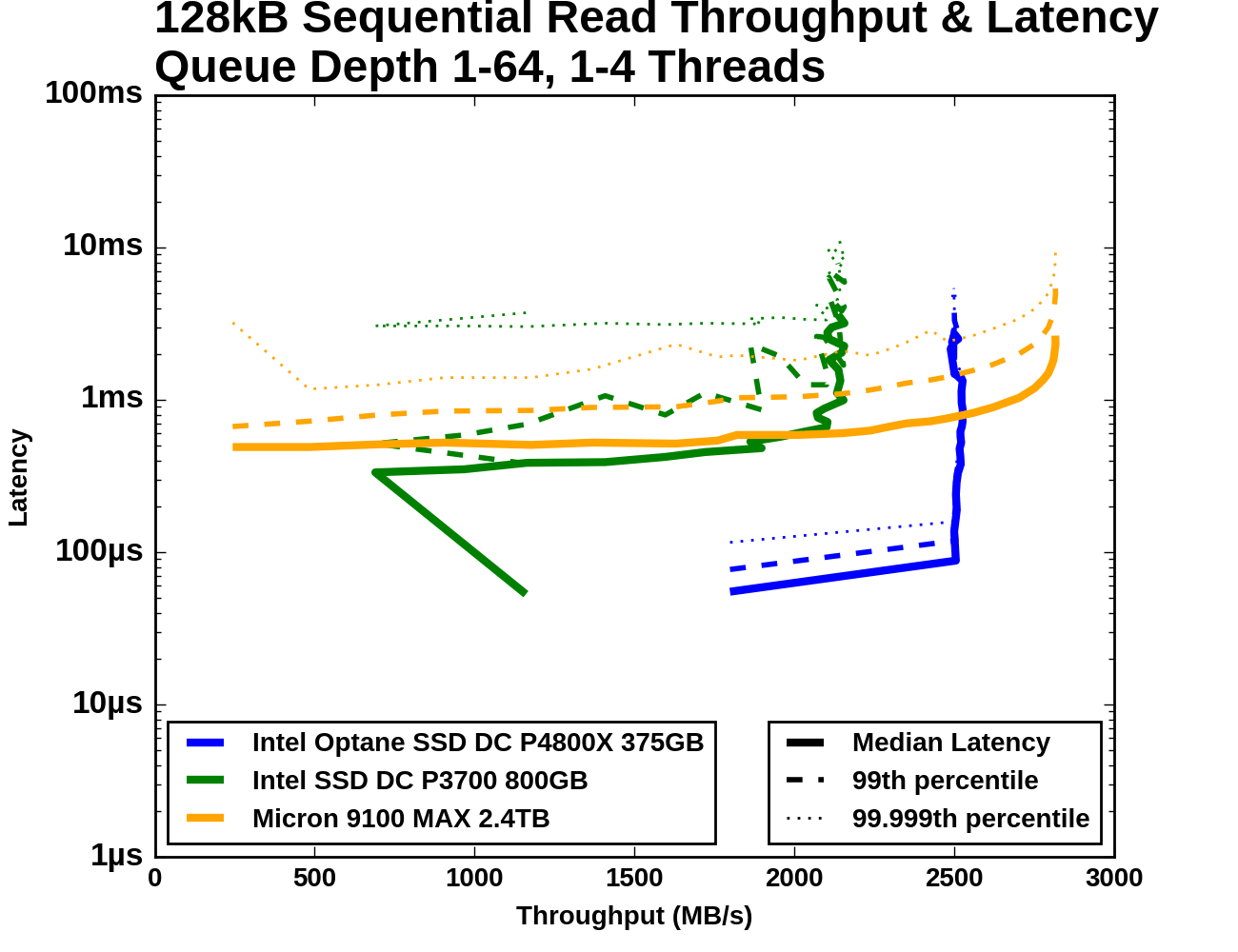
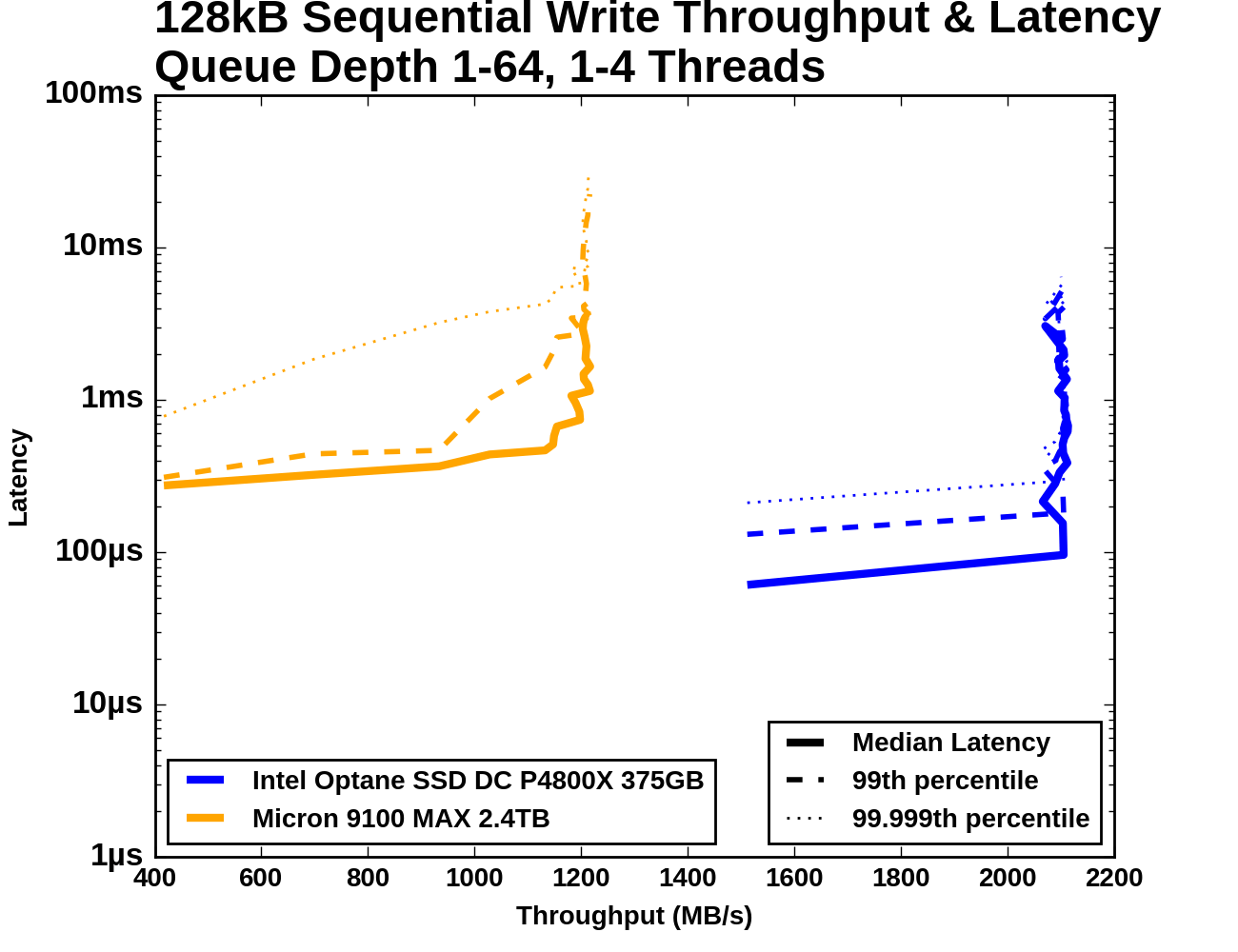








117 Comments
View All Comments
melgross - Tuesday, April 25, 2017 - link
You're making the mistake those who know nothing make, which is surprising for you. This is a first generation product. It will get much faster, and much cheaper as time goes on. NAND will stagnate. You also have to remember that Intel never made the claim that this was as fast as RAM, or that it would be. The closest they came was to say that this would be in between NAND and RAM in speed. And yes, for some uses, it might be able to replace RAM. But that could be several generations down the road, in possibly 5 years, or so.tuxRoller - Sunday, April 23, 2017 - link
I'm not sure i understand you.You talk about "pages", but, i hope, the reviewer was only using dio, so there would be no page cache.
It's very unclear where you are getting this "~100x" number. Nvme connected dram has a plurality of hits around 4-6 us (depending on software) but it also has a distributed latency curve. However, i don't know what the latency at the 99.999% percentile. The point is that even with dram's sub-100ns latency, it's still not staying terribly close to the theoretical min latency of the bus.
Btw, it's not just the controller. A very large amount of latency comes from the block layer itself (amongst other things).
Santoval - Tuesday, June 6, 2017 - link
It is quite possible that Intel artificially weakened P4800X's performance and durability in order to avoid internal competition with their SSD division (they already did the same with Atoms). If your new technology is *too* good it might make your other more mainstream technology look bad in comparison and you could see a big drop in sales. Or it might have a "deflationary" effect, where their customers might delay buying in hope of lower prices later. This way they can also have a more clear storage hierarchy, business segment wise, where their mainstream products are good, and their niche ones are better but not too good.I am not suggesting that it could ever compete with DRAM, just that the potential of 3D XPoint technology might actually be closer to what they mentioned a year ago than the first products they shipped.
albert89 - Friday, April 21, 2017 - link
Intel wont be reducing the price of the optane but rather will be giving the average consumer a watered down version which will be charged at a premium but perform only slightly better then the top SSD. The conclusion ? Another over priced ripoff from Intel.TheinsanegamerN - Thursday, April 20, 2017 - link
the fastest SSD on the consumer market is the 960 pro, which can hit 3.2GB/s read under certain circumstances.This is the equivalent of single channel DDR 400 from 2001. and DDR had far lower latencys to boot.
We are a long, long way from replacing RAM with storage.
ddriver - Friday, April 21, 2017 - link
What makes the most impression is it took a completely different review format to make this product look good. No doubt strictly following intel's own review guidelines. And of course, not a shred of real world application. Enter hypetane - the paper dragon.ddriver - Friday, April 21, 2017 - link
Also, bandwidth is only one side of the coin. Xpoint is 30-100+ times more latent than dram, meaning the CPU will have to wait 30-100+ times longer before it has data to compute, and dram is already too slow in this aspect, so you really don't want to go any slower.I see a niche for hypetane - ram-less systems, sporting very slow CPUs. Only a slow CPU will not be wasted on having to wait on working memory. Server CPUs don't really need to crunch that much data either, if any, which is paradoxical, seeing how intel will only enable avx512 on xeons, so it appears that the "amazingly fast" and overpriced hypetane is at home only in simple low end servers, possibly paired with them many core atom chips. Even overpriced, it will kind of a decent deal, as it offers about 3 times the capacity per dollar as dram, paired with wimpy atoms it could make for a decent simple, low cost, frequent access server.
frenchy_2001 - Friday, April 21, 2017 - link
You are missing the usefulness of it entirely.Yes, it is a niche product.
And I even agree, intel is hyping it and offering it for consumer with minimal benefit (beside intel's bottom line).
But it realistically slots between NAND and DRAM.
This review shows that it has lower latency than NAND and it has higher density than DRAM.
This is the play.
You say it cannot replace DRAM and for most usage (by far) you are true. However, for a small niche that works with very big data sets (like for finace or exploration), having more memory, although slower, will still be much faster than memory + swap (to a slower NAND storage).
Let me repeat, this is a niche product, but it has its uses.
Intel marketing is hyping it and trying to use it where its tradeoffs (particularly price) make little sense, but the technology itself is good (if limited).
wumpus - Sunday, April 23, 2017 - link
Don't be so sure that latency is keeping it from being used as [secondary] main memory. A 4GB machine can actually function (more or less) for office duty and some iffy gaming capability. I'd strongly suspect that a 4-8GB stack of HBM (preferably the low-cost 512 bit systems, as the CPU really only wants 512bit chunks of memory at a time) with the rest backed by 3dxpoint would still be effective at this high latency. Any improvement is likely to remove latency as something that would stop it (and current software can use the current stack [with PCIe connection] to work 3dxpoint as "swappable ram").The endurance may well keep this from happening (it is on par with SLC).
The other catch is that this is a pretty steep change along the entire memory system. Expect Intel to have huge internal fights as to what the memory map should look like, where the HBM goes (does Intel pay to manufacture an expensive CPU module or foist it on down the line), do you even use HBM (if Ravenridge does, I'd expect that Intel would have to if they tried to use xpoint as main memory)? The big question is what would be the "cache line" of the DRAM memory: the current stack only works with 4k, the CPU "wants" 512 bits, HBM is closer to 4k. 4k looks like a no-brainer, but you still have to put a funky L5/buffer that deals with the huge cache line or waste a ton of [top level, not sure if L3 or L4] cache by giving it 4k cache lines.
melgross - Tuesday, April 25, 2017 - link
What is it with you and RAM? This isn't a RAM replacement for most any use. Intel hasn't said that it is. Why are you insisting on comparing it to RAM?